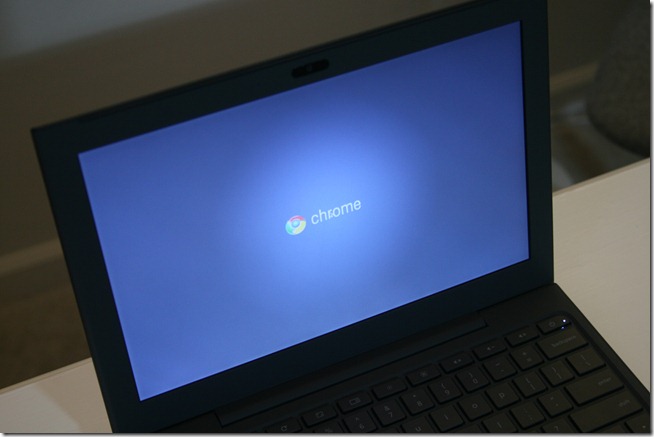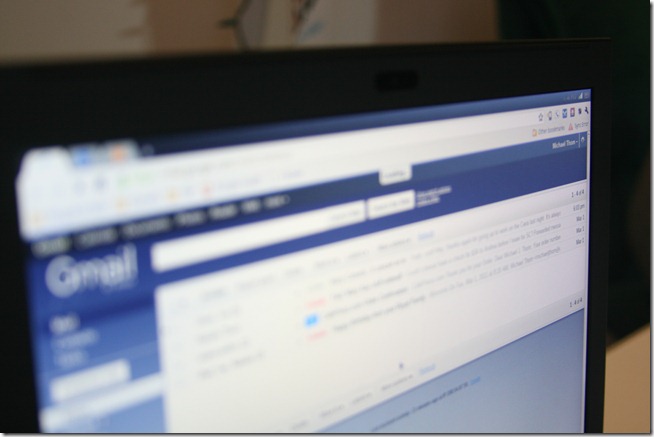Review of Google’s Cr-48 Chrome OS Pilot Program
Author’s Note:
This article was to be posted on another blog in March. Unfortunately, that never happened, so it is a bit out of date. (Most significantly, production models of the netbook have been announced; see my note on that below.) Nonetheless, I liked my review of the product, so I wanted to post it here anyway. Enjoy!
I won the lottery recently. Well not actually, but it sure felt like I did: I received one of Google’s Cr-48 Chrome OS laptops as a part of their pilot program. Though I applied back in December 2010, I had nearly forgotten about it altogether, having just assumed I wouldn’t be selected. But alas, there it sat at my doorstep. I couldn’t wait to play with it.
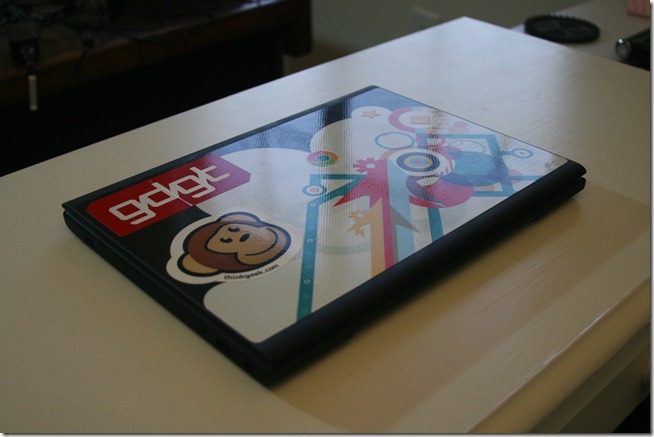
It came with this sticker in the box (I then added the gdgt and ThinkGeek stickers).
The Hardware – A Brandless Black Beauty
From a hardware standpoint, I’ll join the rest of the blogosphere in admitting that my first reaction – before even turning it on – was “wow this looks and feels a lot like the original black MacBook.†No wonder: it has a matte black finish, nicely separated “Chiclet†keys, a 12.1†display, a large touchpad (with built-in click ability, no separate button), and very few ports on the outside of the case: only VGA, USB, headphones, power, and SD card ports. One of each. Nothing more.
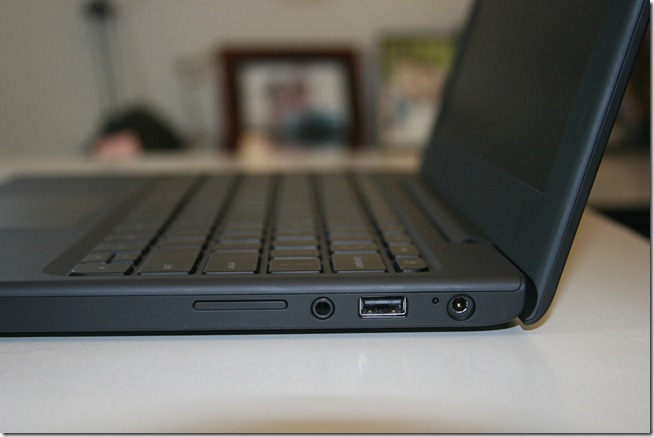
Just SD card, headphones, USB, and power ports here (with a power indicator light); VGA is on the other side.
The real magic to the hardware, though, is the 16 GB SSD. The nature of a solid-state drive is that there are no moving parts. The physical movement of the read head and spinning platters of a typical hard drive is the biggest limitation to seek time and overall performance – the drive has to literally find the data on the drive before serving it up to the system. With an SSD, this seek time isn’t decreased, it’s eliminated. Thus, a complete system boot-up takes roughly 10 seconds. Ten. Seconds. Close the lid and it goes to sleep almost instantaneously, and it wakes just as quickly. It’s worth noting, of course, that even with 2 GB of RAM, actions on the web are still limited by bandwidth (a page will only load as fast as it can be downloaded and rendered, neither of which are primarily reliant on the hard drive) and processing speed (a high-definition movie on YouTube playing in Flash still puts a huge strain on the admittedly under-powered 1.66 GHz Atom N455 processor on board).
Three more quick comments on the hardware. First, it ships with a Bluetooth radio, but it is not yet activated in the current version of OS. Second, there is also a CDMA-enabled 3G broadband radio on board, and the pilot program comes with 2 years of (100 MB per month) Verizon Wireless broadband service included. Last, the removable battery is actually fairly sizeable, both in physical size and in capacity (63 Wh); I do see actual 7- or 8-hour performance out of it, running on WiFi (I haven’t really tested the battery much with the 3G yet, largely because I would likely empty my 100 MB usage long before the battery would run out!).
The Software – Chrome OS
This is the most intriguing part of this experiment, and it’s clearly the part that Google is interested in getting feedback on. I am no stranger to the Google Chrome browser, and I have it installed on all of my computers. However, I had never made it my primary browser; I have been a disciple of Mozilla Firefox for as long as I can remember. I’ve been tempted at times in the past to leave Firefox for Chrome, but my extensions in Firefox were reason enough to stay where I was comfortable, despite some of Chrome’s great features and speed.
But turning my Cr-48 on for the first time, I was introduced to a login screen for a Google Account. You cannot create an account on this computer without having a Google Account. Once I entered my login information, it immediately updated the computer’s bookmarks with my bookmarks (because they had been synced from one of my other computers using Google’s Chrome Sync). I had not previously used any Chrome extensions, so there was nothing to import, but reportedly it would have imported and activated my Chrome extensions as well. So there I was, staring at a Google Chrome browser. Or should I say I was looking at Google Chrome OS? Hard to decide; they are one-and-the-same. For example, the wrench menu in Chrome: on a desktop computer, that menu has an “Options†choice; in Chrome OS, it is instead called “Settings†and is the closest thing this computer has to a “Control Panel†or “System Preferences.†There are not many settings available here, but all the system settings you’d expect (such as Date and Time, Networks, Users, etc.) are available here, in addition to Chrome browser settings (ahem, Options) such as Basics, Personal Stuff, and Under the Hood.
That’s it! No other software to run whatsoever. You cannot minimize the browser, because the browser is the OS is the browser. To quit the browser (Ctrl-Shift-Q) is to log out of your account. It’s odd, but powerfully simple.
The Experience – I’m a Google Guy, in a Google World
Using a Chrome OS netbook such as this is definitely an experience best approached from the perspective of a diehard Google adherent. I suppose that you could say that I am just that: I use Gmail for personal email, I have a Google Apps account, I use a Google Nexus One phone (running Google’s Android OS of course), I manage all my calendars and contacts through Google, Google Reader is my RSS reader, and I use Google Documents. Even so, I had yet to make the actual switch to using Chrome full-time on my personal computers. However, the receipt of this Chrome OS netbook was all the encouragement I needed. From wanting to take advantage of Chrome Sync to simply wanting continuity in my day-to-day browsing, I took the plunge and relegated Firefox to backup duty only.
How significant is this? For me, it was only mildly impactful. Using Chrome is not an incredibly different experience from using Firefox. More importantly, I had already set Google as my default search engine in Firefox (and Internet Explorer, for that matter), so I was already sending all my queries to the Goog. So in that sense, my experience (and my daily contribution to their ad revenue) did not change considerably. However, I am not one of those people who searches Google for Facebook, but instead I use Ctrl-Enter to go straight to the site. Again, with Chrome, this is even one step easier (it auto-fills the www. and .com without even having to press Ctrl-Enter).
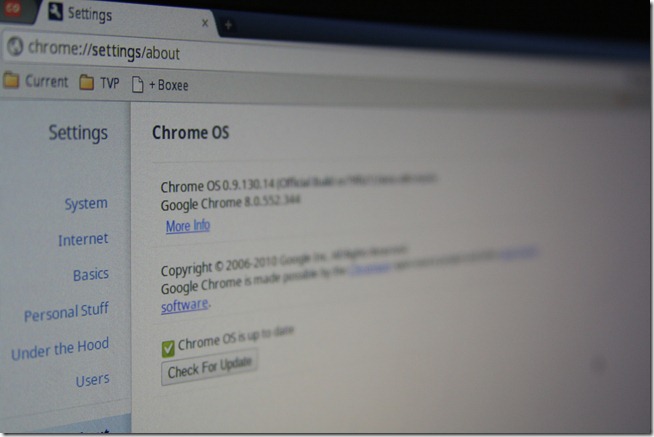
The Settings screen is concise and easy to use.
Chrome OS ships by default with a Search key in place of a Caps Lock key (though this is reconfigurable to Caps Lock). I’ll admit it’s not difficult to press Ctrl-T (to open a new tab) and then enter a search query, but it’s even easier (and still somewhat novel) to just punch the Caps Lock (I mean Search) key and bring up a new tab to enter your search. I often find myself sitting in front of the TV with my Chrome OS netbook in my lap, and now I’m even more likely to hit the Search key and look up an actor, a show, or a product.
How Might This Impact the Industry?
Google already has a significant stronghold on the search industry. In January ComScore indicated that Google had almost exactly two-thirds of the search market, with Bing actually increasing its share to about 12% and Yahoo! dropping its share to 16%. Bing is the default search engine in Internet Explorer, and many people leave this setting when they get a new computer. But if a Google Chrome OS-based netbook was a popular commercial option, then this would encourage a further shift toward Google picking up the last few percentage points of market share, as these default-setting people would just leave Google as the default search engine on their Chrome netbook. Further, as indicated from my own experience, I’m even more likely now to search Google for random things as I think about them, since it’s an even more readily accessible experience.
Will Google eventually come to market with a commercially-available Chrome OS netbook? I believe they will, but it may be a while still. If they can price it competitively (I’m thinking between $200-300 for a netbook like the pilot machine I have), then it could be a huge success. There is a large portion of the population for whom this type of machine (a “netbook†in the truest sense of the word) is perfect: those who are new to computers and/or really only ever do email, Facebook, and internet or those need a light-duty second (or third or fourth!) machine. Those people are hesitant to spend the $400, $500, or $600 for a low-end Windows PC (and especially $1000 for the cheapest Mac) because those computers simply are more powerful than they need and offer features they’ll rarely use. Google’s purpose-built Chrome OS netbook, though, could be a game changer for them. Here’s to hoping it becomes a reality!
Postscript:
Google has now, of course, announced the first production Chromebooks: one by Samsung and one by Acer. Other than what’s posted on Google’s website, I don’t know anything specifically about those models. They do look intriguing, though I feel the price points are too high. I still believe that these will never be anyone’s primary (or only) computer. Therefore, I’m not sure the price point is low enough to justify a purchase for most people. Nonetheless, it’s a very interesting concept, and it will be fun to watch the sales figures!
